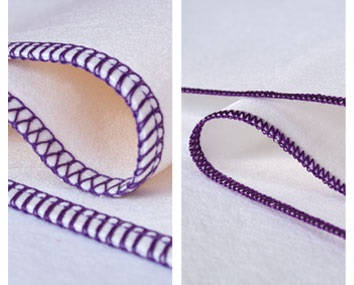Serger vs Sewing Machine – What’s the Difference?
If you’re anything like me then somewhere along your sewing journey you come across a serger and asked yourself – what is a serger and do I need one?
I hope to give you a clear comparison of a serger vs. a sewing machine and help you figure out if a serger is something worth investing in.
Serger vs. Sewing Machine – The Key Difference
You are likely familiar with what a basic sewing machine does so let’s focus o
n what a serger is.
Simply put, a serger can be considered as a specialized sewing machine – sometimes referred to as an overlock sewing machine.
Take a look at the image to the right – what you see are beautiful edges that are neatly finished with a serger.
Without serging the edge, it would look unfinished and unprofessional, and the fabric will fray over time.
Sergers take anywhere from 3 to 8 thread cones at a time, and loop thread around the edge of the fabric, which prevents fraying. The Singer serger to the right has 5 cones.
The most common sergers use 3 to 4 cones of thread. Compare this to a sewing machine where you typically use just one thread or possible 2 if you are using a double needle.
Because of the multiple threads being looped together, a serger makes a more professional and durable seam than a standard sewing machine.
The threads lock around the seam to prevent fraying, and it also has a blade that cuts off the seam allowance as it sews (the blade can also be turned off if you like).
One of the great features of a serger is how fast they are – it trims away seam allowances and encases raw edges – all at up to speeds of 1700 stitches per minute!
Similar Features of the Two
The interesting thing is that a serger can actually do a lot of things that sewing machines can do. Some examples are:
This video does a great job visualizing some of the similar features of a serger and sewing machine (and its kinda funny too).
What a Serger Cannot Do
A serger has its strengths and can speedily create durable and professionally finished edges, but it is not a stand-alone machine so it isn’t able to replace a standard sewing machine for most projects.
You will still need your trusty sewing machine to do buttonholes, zippers, facings, and topstitching.
Do I Really Need Both?
In short, you do not need a sewing machine and a serger. But here’s the thing – you can get away with many projects using only a sewing machine without a serger. So a good quality basic sewing machine is a must, and a serger is something you will add as you gain experience and see a need for its features.
Some things to keep in mind if you are thinking about purchasing a serger:
Keep in mind that there are “overlock” foot attachments for standard sewing machines, and many are content with the quality of finished edges it can make. But others point out that an overlock attachment simply cannot make as durable of a stitch as a serger with multiple looping threads.
A Final Note
I purchased a Brother 1034D a few months after I learned how to sew because I wanted more professional looking finishes. There is a learning curve – especially trying to figure out how to set it up with 4 different threads, but from the start I absolutely loved what it is capable of doing. I have it out on my sewing table and use it with ease.
What I heard is that once you try out a serger you won’t want to do without it. Well I can say that was definitely true in my case – the speed, power, and beautifully finished edges are something I can’t do without now that I have one.
If you aren’t sure about spending $200 or more on a serger then I would recommend going into a local sewing shop and using one to see what you think.
via Sewing Machine Savvy – Best Reviews and Comparisons http://www.sewingmachinesavvy.com/serger-vs-sewing-machine/

